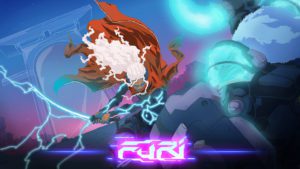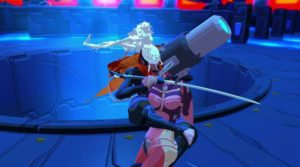
As I start to play Furi, I can’t help to think in Afro Samurai, Takashi Okazaki is responsible for the character design, so the spirit of Afro Samurai is here. The whole set-up of a laconic samurai with an enigmatic, possibly imaginary friend makes things very familiar for me. In Furi, you take control of a Katana wielding guns blazing samurai trying to escape from his jail (won’t spoil much of the story), while a Bunny Masked “friend” goes with you along the way. If I could describe Furi, I would say that is a hack and slash boss rush, bullet hell experience, that is by no means easy but so satisfying with each victory.

Furi’s greatest strength is it combat. Armed with your katana and a gun, you tackle each of the game’s bosses, but they are not a walk in the park. You attack with the Y button attack with your Katana, and the Right Stick is your laser gun, seems simple right? It is; however, if you think you are going to shoot your way to victory, you have another thing coming. Furi has a system similar to the Field phase and Duel Phase in Pokken Tournament (to put it simply). After dealing certain amount of damage, your enemy goes into a “orange” state in which you have to be fast and slash it to perform a devastating attack and shift into a more up close and personal fight. This is where things change. You no longer can spam projectiles with your gun here is a manly fight to the death, but it doesn’t mean also that you can spam slash attacks.
Furi excels in giving you a game in which you have to wait for the opportunity to dish damage, watching enemy patterns and attacks and learning when to counter and attack is essential if you want to win. Luckily, you have several tools at your disposal. When in close quarters combat, with the A button you can Parry, if you press it just before an attack connects you regain a little health and you can follow up with a combo. But parrying is not always the best way. Sometimes you need more power in your attacks so that is why the charged attack is the best choice in this types of situations. Holding down the Y button for a few seconds will put your character in a focused stance. Releasing it will perform a powerful combo attack that will break the enemy’s defenses.

Speaking of charged attacks, you can also charge your shots with ZR, which is useful when your opponent is far away. With the B button, you can perform a dodge useful to avoid attacks, especially the most powerful ones. When you have deal certain amounts of damage, the enemy enters a invincible state and the bullet hell element becomes apparent. During this time, you cannot harm the enemy, but you need to shoot constantly to avoid being hit by the multiple bullets and use B to dodge large area attacks.
The music and art style used in Furi is superb. It blends really well with the rest of the game, and the dark tone of the story and fight for freedom is one of the best I have seen so far for Nintendo Switch. I personally love that this types of games arrive to this console, so us adult gamers can enjoy them as well. The difficulty here is high. You WILL die a lot, but you can lower the difficulty if needed. I would not have it any other way, though. I prefer to try again until I win than to have a dumbed-down experience which appeals ore to audiences (this is only my opinion). However, there is nothing wrong in playing at a lower difficulty setting if that’s what you prefer to do.
Bottom Line: Furi is one of those hidden gems in the Nintendo Switch library, but be warned: it is hard, but not impossible. It is a great combination of bullet hell and hack ‘n slash mechanics, and the anime-influenced style fits like a ring. I definitely recommend it to players wanting a good challenge with moderate to unforgiving difficulty, but casuals might not think so. Even so solid controls and great soundtrack make Furi a must buy.

